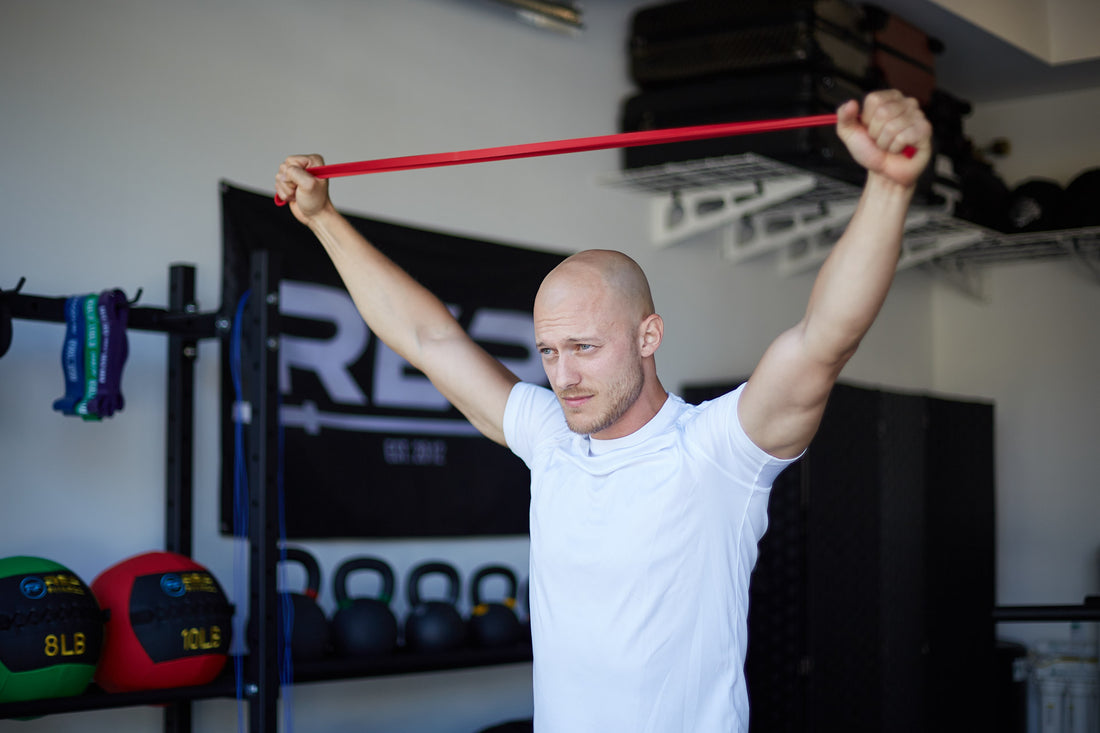
They’re called Pull-Up Bands, but they’re for so much more than just pull-ups. These stretchy, long loops can be the cornerstone of a great, full-body workout that takes up minimal space and costs next to nothing.
There are several different types of bands for working out. Pull-Up Bands, specifically, come in seven sizes with varying widths and colors (for easy identification). They start with XXX-light (yellow) that feels like 5-15lbs resistance, and they top out at X-heavy (orange), which creates 70-175lbs of resistance.

The size variations are designed for different levels of fitness and purposes, such as training for a pull-up or providing an extra challenge on compound lifts. To add resistance while weight training, attach the bands to power racks with band pegs and then loop the bands around your barbell.
You can also attach resistance bands to weight stacks to add difficulty.

These bands are crafted out of layered elastic, which provides smooth and consistent tension. Layered elastic is also strong and durable. No sticking points or sudden snags.
How to Use Pull-Up Bands
You can get a full-body, strength-training workout with just resistance bands. Research shows they can also help your flexibility, balance, gait function, and more. Add them into your existing home gym for variation – or use them to start your gym if you’re on a budget. Resistance bands are inexpensive, take up barely any space, and are versatile.
Here are some exercises to try. Choose four or five and do each one for 30 seconds to a minute, followed by a short break. Repeat three to four sets.
Upper Body Exercises with Resistance Bands
Pull-ups: Hence the name, Pull-Up Bands are great for assisted pull-ups. Attach the bands to band pegs on your power rack; loop them around your pull-up bar and put your feet in the bottom loop; or you can even put your J-cups on your rack’s front uprights and hook the pull-up band on each cup so it creates a horizontal platform for you to put your feet on.

Banded bench press: You can perform these with just resistance bands, or loop the bands around your barbell to change the resistance so it’s harder at the top of the press. This helps you practice your lockout. Most people are also stronger at the top of the lift than the bottom of the lift, so bands work the natural strength curve of the lift, according to Barbell Logic.
Here’s a video about how to incorporate bands into powerlifting's Big 3 (squat, bench, deadlift). Tip: When putting your bands around a barbell, try to keep them on the smooth sleeves, not on the knurled shaft, to protect the bands.
Wood choppers: These are great for shoulder and core strength. Step on the center of your band and grab the other end. Start with your hands near your knee and pull the band across your body diagonally, keeping your arms straight. End with your hands over your other shoulder.

Band pull-aparts: With each hand, grab two ends of the band. How close or far apart your hands are on the band affects the difficulty, but make sure it’s close enough for tension and a challenge. You can do these overhead, with arms straight overhead, palms facing away. Pull the band apart until they reach a “T.” Or extend your arms in front of you, palms facing down. Pull into a “T.”
Tricep kickbacks: Stand on one end of the band or affix it to an upright and hold the other end of the band in one hand, with your elbow locked into your side, palms facing inward. Straighten your arm and then return to a 90-degree bend to hit that tricep. Here’s how it looks.
Other upper-body resistance band exercises:
- Tricep press-downs or overhead extensions
- Upright rows
- Overhead presses (standing or kneeling)
- Lateral raises
- Plank rows
- Bicep curls
- Bent-over rows
- Face pulls
- Russian twists
Lower Body Resistance Band Exercises

Circle Hip Bands are a great type of band for most lower-body banded exercises. However, you can use the thinner, longer Pull-Up Band for your lower body, as well. Here are some ways.
Deadlifts: You can do resistance band deadlifts, with the wrapped around the arches of your feet, holding the band with both hands. You can also affix bands on band pegs to your barbell to increase tension at the lockout.
Front Squats: Like the other barbell exercises, do these with the bands alone or looped around your barbell. Band only: Stand on the band, holding one end of the band in each hand. Bend your arms toward your ears until your triceps are parallel to the floor. Squat, keeping your arms from moving. You can also use bands for back squats/regular squats.
Other lower body resistance band exercises:
- Lunges or drop lunges
- Leg extensions
- Sumo squats
- Single-leg deadlifts or straight-leg deadlifts
- Calf presses
- Kick outs
- Donkey kicks

NEWSLETTER SIGNUP
Product launch information, promotions, blogs, and REP news.







